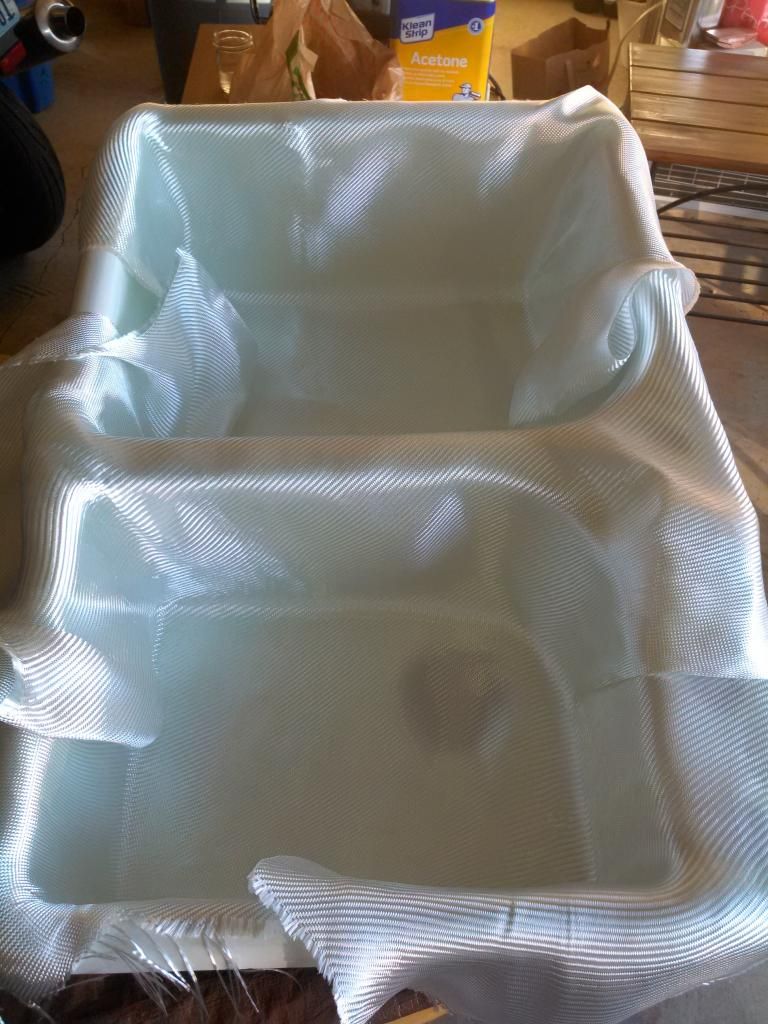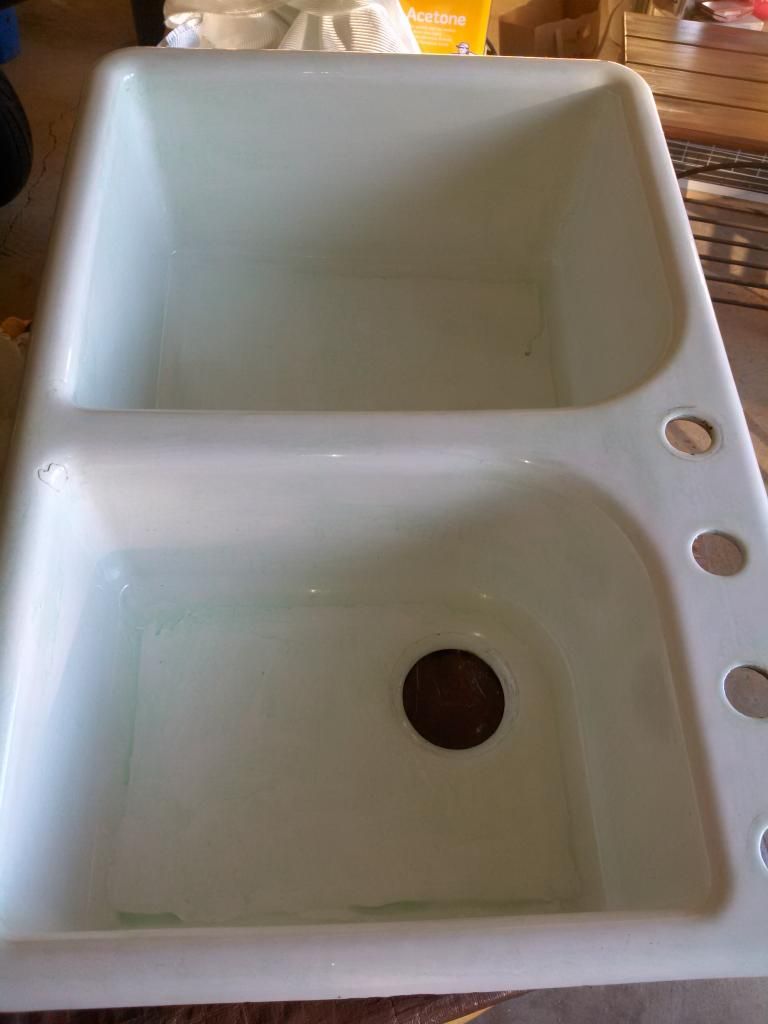 10-21-2013, 09:33 PM
10-21-2013, 09:33 PM
|
#1 (permalink)
|
|
Human Environmentalist
Join Date: Aug 2010
Location: Oregon
Posts: 12,940
Thanks: 4,358
Thanked 4,512 Times in 3,471 Posts
|
Making a Fiberglass Mold
My friend just offered to make a concrete countertop with integrated sink as a wedding present. In preparation for this project, I have purchased a used sink that has the basic shape I want for $25. My plan is to make a fiberglass mold of the interior of the sink, and use that to form the integrated concrete countertop/sink.
I've already prepped the sink by waxing with carnuba and have applied a film of PVA as a mold release. Now I'm to the point of cutting the fiberglass and laying it in with polyester resin. Should I cut slits in the fiberglass along the 4 or 5 folds seen in the picture, or would it be better to cut the mat into different smaller shapes?
Should I wet lay it (coat the sink with resin first), or dry lay it (push the resin through the fiberglass mat)?
My plan is to start with a layer of fiberglass, then a layer of thin perforated foam core, and then another layer of fiberglass. Hopefully this provides enough structural rigidity, but if it doesn't I will just continue on with more layers.
I'm using a polyester resin, so adding layers shouldn't be a problem. Mostly I'm concerned with getting the first layer going without any bubbles or other surface imperfections. What are your tips?


|
|
|

|
 Today Today
|
|
|
|
 Other popular topics in this forum...
Other popular topics in this forum...
|
|
|
|
 10-22-2013, 02:01 AM
10-22-2013, 02:01 AM
|
#2 (permalink)
|
|
NightKnight
Join Date: Dec 2008
Location: Placerville, CA
Posts: 1,595
Thanks: 315
Thanked 314 Times in 187 Posts
|
Subscribed... I have similar questions...
__________________

|
|
|

|
 10-22-2013, 10:59 AM
10-22-2013, 10:59 AM
|
#3 (permalink)
|
|
Human Environmentalist
Join Date: Aug 2010
Location: Oregon
Posts: 12,940
Thanks: 4,358
Thanked 4,512 Times in 3,471 Posts
|
Well I'm laying up the fiberglass today regardless of how expert I feel about it. I'll report back how it goes and post some pictures.
|
|
|

|
 10-22-2013, 08:27 PM
10-22-2013, 08:27 PM
|
#4 (permalink)
|
|
Human Environmentalist
Join Date: Aug 2010
Location: Oregon
Posts: 12,940
Thanks: 4,358
Thanked 4,512 Times in 3,471 Posts
|
I'm throwing in the towel.
On the first attempt, my concrete friend tried to wet lay the fiberglass directly on the porcelain with no mold release. The mold was a bit stubborn coming out, but the basic shape was there, although way too flimsy with just a single layer. There were a few air pockets, mostly around the corners, that did not lay flush with the contour of the sink.
After an hour of scraping the old resin out with a razor blade, I prepped the sink with carnauba wax and applied a layer of PVA. The PVA seemed to bead up and pool in the bottom of the sink, despite trying to put as thin a layer as possible on. The green stuff in the sink of the picture above is the pooled PVA. It doesn't create an even coat.
My second attempt at fiberglassing was again a wet lay. Again, we attempted to lay the fiberglass in a continuous piece, cutting a relief where extra material formed. The problem with wet laying is that the fiberglass strongly adheres to any surface it comes in contact with. Once that happens, pressing the fiberglass into the contours and corners becomes impossible.
I'm thinking the correct way to do this is to lay the fiberglass in strips, just a small section at a time. With just 8 min to work with the resin, you can't do large areas fast enough.
I'll take the sink to a fiberglass shop and see how much they would charge to make a mold. If it's more than $100, then I'll just buy an undermount stainless steel sink and give up the idea of having a 1 piece countertop/sink.
|
|
|

|
 10-22-2013, 08:42 PM
10-22-2013, 08:42 PM
|
#5 (permalink)
|
|
Hydrogen > EV
Join Date: Apr 2012
Location: NW Ohio, United States
Posts: 2,025
Thanks: 994
Thanked 402 Times in 285 Posts
|
You inspired me to look into fiber glass for my next lower grille block. I'm sorry it didn't work out well for you.
Did you try or consider the dry method?
|
|
|

|
 10-22-2013, 11:39 PM
10-22-2013, 11:39 PM
|
#6 (permalink)
|
|
EcoModding Lurker
Join Date: Mar 2013
Location: North Alabama
Posts: 23
Thanks: 4
Thanked 5 Times in 3 Posts
|
I've seen concrete counter tops and really like them but have no idea how they are made. Was the plan to press the mold into the concrete (male mold) to make the sink?
I've played around with concrete some and found that buoyancy tends to push the molds up so they float on top. When you try to hold the mold down in place it tends to deform the mold unless it's really stiff. Otherwise you can fill the mold with something just as dense as the concrete.
You could just pour concrete in the sink and make a concrete mold, paint it and apply mold release, but your out of luck if it won't come out of the sink and you might need room for an engine hoist in the kitchen, 'cause it'll be heavy (cast a hook in). Still have to be careful about air bubbles, but may be able to touch it up.
|
|
|

|
 10-23-2013, 12:53 PM
10-23-2013, 12:53 PM
|
#7 (permalink)
|
|
Master EcoModder
Join Date: Jan 2008
Location: Sacramento, CA
Posts: 406
Thanks: 35
Thanked 143 Times in 105 Posts
|
Redpoint,
You probably need to try a twill weave for your glass. It conforms to contours much better than a unidirectional weave. You should have much more working time with your resin. Most are workable for 20 minutes to half an hour. I would try cutting the glass into a few pieces so you wouldn't have to do the slice and dice with the corners. One method of laying the fiberglass in is to get some spray on adhesive like 3M 77(I think) and to lightly spray the surface of the mold you are using and then position the cloth in it. Then use the resin and a small paint brush to work the resin in.
Also, I would think you would need at least six to ten layers to make a good stiff mold that isn't too flexy. That would be using 5.8 oz. per square yard material.
Are you using spray on or paint on PVA? If you can use a spray gun you can usually get a fairly good coating without much drip with a little patience.
I am by no means an expert, these are just a few things I've learned over the last couple years of playing with that stuff.
JJ
Last edited by jjackstone; 10-23-2013 at 12:55 PM..
Reason: Additional info
|
|
|

|
|
The Following 2 Users Say Thank You to jjackstone For This Useful Post:
|
|
 10-23-2013, 06:57 PM
10-23-2013, 06:57 PM
|
#8 (permalink)
|
|
Human Environmentalist
Join Date: Aug 2010
Location: Oregon
Posts: 12,940
Thanks: 4,358
Thanked 4,512 Times in 3,471 Posts
|
Quote:
Originally Posted by UltArc

Did you try or consider the dry method?
|
As Jack points out, you need a method of sticking the fiberglass to the walls of the sink. He suggests using an adhesive, in which case I think dry laying would work well. It would also allow me to cut and form the glass without having the time constraint of the resin. The other advantage of Jack's suggestion is that leaving the fiberglass dry allows it to be touched without sticking to the object touching it. I found with the wet method that the resin soaks through the fiberglass and then the fiberglass sticks to the gloved hand when you are attempting to position it. I kept poking at the corners trying to get the glass to lay flat in them, but it would adhere to my finger when I drew it away.
I do believe the instructions called for way too much catalyst too. It said 10 drops per ounce. If I had used 1/3 of that, I should have had much longer working time.
Quote:
Originally Posted by JeffD

I've seen concrete counter tops and really like them but have no idea how they are made. Was the plan to press the mold into the concrete (male mold) to make the sink?
|
The inside of the sink is the contour to be molded, so laying the fiberglass in it creates a "negative" of that shape. While the sink creates a smooth bowl, the "negative" fiberglass mold creates a smooth mound (opposite of a bowl). The fiberglass mold is then set inside the form used to create the counter, smooth mound side up. A box is formed around the fiberglass mold, and concrete is poured between the box and the fiberglass mold. Since the fiberglass is a negative of the sink, the concrete that forms around it becomes the exact shape of the sink.
|
|
|

|
|
The Following User Says Thank You to redpoint5 For This Useful Post:
|
|
 10-23-2013, 10:51 PM
10-23-2013, 10:51 PM
|
#9 (permalink)
|
|
Hydrogen > EV
Join Date: Apr 2012
Location: NW Ohio, United States
Posts: 2,025
Thanks: 994
Thanked 402 Times in 285 Posts
|
This video has made me extremely confident in the potential of fiberglass.
I looked it up when you posted this, but just started to watch the video about 9 minutes ago.
How to Fiberglass: 12 Steps - wikiHow |
|
|

|
 10-24-2013, 01:18 AM
10-24-2013, 01:18 AM
|
#10 (permalink)
|
|
Master EcoModder
Join Date: Jan 2008
Location: Sacramento, CA
Posts: 406
Thanks: 35
Thanked 143 Times in 105 Posts
|
Another to think about is not to mix too large a batch of resin at a time and not to mix it in too small of a container. Each of these can cause the resin to start curing too soon. If your resin mix was getting hot in container then that was probably why it only gave an 8 minute working time. Guess how I know about that. Actually almost started a fire once by mixing too much resin on a hot day. Just took a few minutes and the resin was smoking.
JJ
|
|
|

|
|